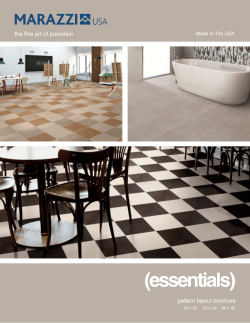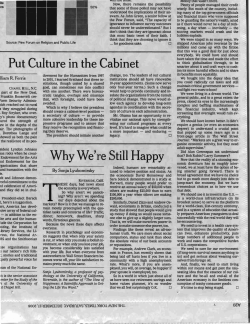
Tile for the Mid-Century Modern Home by Robin Fisher
nwsid.org nwsidpdx@nwsid.org 503-222-4664 Tile for the Mid-Century Modern Home by Robin Fisher One of my biggest pet peeves is when professional designers use “modern” and “contemporary” to describe a style interchangeably, when in fact, they are two completely different design styles. Modern - Pierre Koenig Case Study House #22 Contemporary Skylab Architects “Hoke House” (Twilight’s Cullen House) “Modern” 1935 – 1985. It is commonly believed that Modernism grew as a reaction to the “lavish stylistic excesses of the Victorian Era and Edwardian Art Nouveau” periods. This is the movement of “form follows function” and the house as “a machine for living in”. Although this movement was broadly embraced by commercial architects, residential architects of the time did not, and the Mid-Century Modern style was born. The residential architects created a style that was more organic and accessible while maintaining the clean lines and simplicity of the original movement. This resulted in the open floor plans of the era that helped to incorporate nature and brought the outdoors in. These more relaxed and human designs bought modernism to the people and into America’s post-war suburbs. “Contemporary” On the other hand, Contemporary design, although strongly impacted by the Modern Movement, is influenced by many styles. Contemporary style is aspirational, visionary, risky and is innovative in its use of materials. This style attempts to push the boundaries of materials, technology and geometry. “Mid Century Modern Tile” 1/5 nwsid.org nwsidpdx@nwsid.org 503-222-4664 Now that we have some background on these style differences, I will segue into my discussion on MidCentury tile for your home. The Mid-Century modern movement (1935 – 1964) celebrated the new technology of mass production. The repetitive patterns were organic and geometric. Colors traveled over the entire pallet! This movement evolved over a 30 year time period and the colors of choice changed with the times. Pinks, turquoise, orange, burgundy, black, browns, rust, gold and avocado were all in favor during this period. In the early stages of the Modern movement – tile was reserved for the bathroom, kitchen and fireplace. Bathroom floors were mainly 1” hex tile – typically in white with black accents. Tiles for the wall were commonly 3 x 6 subway and ran the gambit of colors: turquoise, white, black, pink, burgundy or green. Geometric accent liners were used for added interest. Kitchen counters were often hex tiles with a bold color for the v-cap (edge of the counter). Sinks were cast iron with a bead tile around the edge to create an under mount installation. The backsplash was typically the same 3 x 6 subway tile seen in the bath. Bathroom Kitchen As we moved closer to the 1950’s the tile for the kitchen and bath started to change. Geometrics became dominant and colors were brighter. Turquoise, green and pinks were popular with along with matching appliances. Black accent tiles move into the kitchen. Countertops were predominately tile, but plastic laminate with chrome edging becomes the new “trend”. The 1950’s bathroom floor moved from hex tiles to 1” square tiles and wall tile choices evolved to a 4” square. The tile was very linear, bold (black or burgundy) edges with a more subtle, detailed secondary accent liner. 2/5 nwsid.org nwsidpdx@nwsid.org 503-222-4664 The 1960’s pop culture had a strong influence on the interiors of the home. Patterns were heavily influenced by nature and Mediterranean culture. Oranges, browns and avocado green turn out to be the rage! Tile flooring was also influenced by the desire to bring nature indoors. Flagstone slate and stone for entries and fireplaces became popular choices. Stone cladding became prominent in entries and living rooms (consider the Brady Bunch!). Terracotta tiles were frequently used on kitchen floors. Geometrics from pop culture influence patterns found on walls, showers and fireplaces. 3/5 nwsid.org nwsidpdx@nwsid.org 503-222-4664 The influence of nature in the 50’s and 60’s fit perfectly with the current “green movement”. Today’s tile artists have integrated these organic and geometric patterns as inspiration for the tile designs now available. The ideology of Mid-Century modern design incorporates well into the 21st century social zeitgeist of “harmony with nature”. 4/5 nwsid.org nwsidpdx@nwsid.org 503-222-4664 Metolius Ridge - Hydrangea Architerra Austin Article Courtesy of Robin Rigby Fisher, CMKBD, CAPS has over 28 years in the design/build industry in the Portland Metro area. She is an award winning designer who currently works with Pratt & Larson Tile in Marketing and Education and is an instructor in the Interior Design Program at Portland Community College, Sylvania Campus. Her design philosophy is “bad design should be illegal”. robinf@prattandlarson.com | 503-231-9464 5/5
© Copyright 2025





















